6 yoga substitutes for the most common gym pre-exercise stretches
8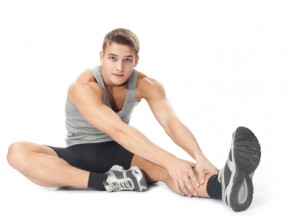 Every time I go to the gym I see somebody doing the anga bangha stretching. Anga bangha means trying to do something good for one part of your body while compromising another part in the process. A seated forward bend is a perfect example. If you look like this while doing it, it means that instead of stretching your hamstrings (which was probably your original intention), you are risking anterior disk compression and SI joint strain. Now why would you want that? There are better ways!
Every time I go to the gym I see somebody doing the anga bangha stretching. Anga bangha means trying to do something good for one part of your body while compromising another part in the process. A seated forward bend is a perfect example. If you look like this while doing it, it means that instead of stretching your hamstrings (which was probably your original intention), you are risking anterior disk compression and SI joint strain. Now why would you want that? There are better ways!
Today we will focus on some of the common pre-exercise stretches and their more effective yoga alternatives.
1. Side neck stretch
There are two problems with this stretch: 1. It is static and 2. It only involves the neck. Your neck doesn’t sit on top of your shoulders as a separate entity, it is linked to your spine, rib cage and shoulder blades via muscles, not to mention the connective tissue that links it to the rest of the body. So to make the neck stretch worth your while you need to move your cervical spine, your thoracic spine and your arms (read more about working with neck tension). The easiest way to adapt this stretch is to coordinate the movement of the head and the arm while keeping your spine in a slight side bend.
HOW-TO: Bend sideways to your right. On the inhale move your left arm over the head in a side sweeping motion and look up (now the entire area between your left shoulder and your left ear is contracted). Exhale: sweep the arm down and behind your hip, while turning your head to look at your right foot (now the same area between your left shoulder and left ear is stretching). Repeat the movement few times and then stay in the pose. If you want to strengthen the neck, stay with your arm up, looking up. If you want to stretch your neck, fold your arm behind your back and look down to the opposite foot. After few breaths, switch sides.
2. Chest stretch
This stretch is commonly recommended to stretch your pecs (chest muscles). Tight pectoralis major muscles pull your shoulders in and rotate them internally, which causes a lot of grief and shoulder pain. This is a common problem since we spend a lot of time hunched over or just doing things with our hands in front of us (which encourages internal shoulder rotation). This stretch is not bad – if you lift the chest while pulling the shoulder blades down it will even work your upper back muscles, which is great. The problem is that this stretch still places your arms into internal rotation. So the pattern that we are trying to discourage here (inward shoulder rotation) only gets reinforced. A more effective solution would be to actually work on rotating your shoulders outward while moving the arms behind you (which will work on releasing tension in the entire pectoralis major muscle).
HOW-TO: Stand with one foot forward and your hands in “hitchhiking” gesture with thumbs pointing forward. Inhale: bend your front knee, lift the chest forward and up, and rotate your arms outward, so that the thumbs and elbow creases are pointing out. Exhale: return to the starting point. For the fist two repetitions keep both arms pretty close to the body, for the next two repetitions keep them at about 45 degree angle, and the next two repetitions slightly below shoulder height. Then stay in the pose with arms out, rotating the shoulders out a bit more as you inhale and releasing the rotation slightly as you exhale. Do not force anything! After you finish, rest for few breaths and then switch sides.
3. Back? Hamstrings? Calves? stretch
Whenever I see somebody attempt this stretch, I am never sure what the person is trying to accomplish. Does he want to stretch his lower back? Hamstrings? Calves? Unfortunately, if either one of those is tight, this stretch won’t work. Simple test: sit on the floor with your legs extended in front of you. If your upper body leans back because your pelvis tips backward, it means that you shouldn’t attempt this forward bend. If you do, you will be reversing your lumbar curve and risking anterior disk compression (jamming your lumbar disks at the front, read more about it). On top of that, you will be stressing your SI joints (read more about it). Neither of those is a good idea. If you want to stretch your back, keep both knees bent generously. When you bend forward your chest should rest on your thighs. If it doesn’t, bend the knees some more.
HOW-TO: Sit with both legs in front of you, bend the knees generously. Inhale: raise the arms up, lengthening the spine. Exhale: gradually place your belly over the thighs first and then bring the chest down, relax the neck. Inhale: lengthen the spine, peel the chest off your legs first, then the belly, lifting all the way up. Repeat 4-6 times, then stay in the forward bend. You should feel the stretch in your back, not your hamstrings. This is not a good hamstring stretch for those who are tight, there are better options (see below).
4. Hamstring stretch
This is a typical stretch that can do more damage then good. Once again, you can strain your SI ligaments or get yourself a pain in the butt #1 if you pull too hard. The problem is that you are leveraging your stretch with the weight of your upper body, which means that you can push beyond your muscle’s capacity. Instead try this simple combo that includes both hamstring contraction (to warm it up) and hamstring stretch. You can place the hands on the back of a chair or a wall at the height that feels comfortable.
HOW-TO: Stand with one foot forward. Inhale: bend your front knee and raise both arms up. Exhale: slowly bend forward, gradually strengthening your front knee. Inhale: bend the knee and raise the arms back up. Continue for four repetitions and then stay with your hands on the back of the chair (or the seat, or the wall). Make your spine as long as you can, pulling both sit bones back.
5. Quad/ hip flexor stretch
This stretch is usually done before or after running. It works fine as a post run stretch, but not so good as pre-run. If your muscles are tight and not warmed up you are more likely to strain the tendons that connect your quadriceps to your knee joint or the shoulder of the holding hand. The following moves are useful to prepare the hips, thighs and shoulders for the stretch.
HOW-TO: Exhale: raise you left knee up. Inhale: move your left leg back, raising both arms. Exhale: move your right knee forward, lowering the arms. Repeat 4-6 times, then put your left foot on the floor behind you and bend your right knee, placing your right hand on it. With every inhalation lengthen through the left side of the body, with every exhalation contract the abdomen to prevent the pelvis from tilting forward.
6. Calf stretch
There is nothing wrong with this stretch, but just like with other stretches, it’s useful to warm up the calves first. And, you can multitask if you hold the pose this way, since you will be stretching the calves, hip flexors and quads at the same time, while also helping yourself breathe better (which is useful for running).
HOW-TO: Inhale: Lift up on the balls of the feet, raising the arms up. Exhale: bring the heels and the arms down. After 6 repetitions put your left foot on the floor behind you and bend your right knee, placing your right hand on it. With every inhalation lengthen through the left side of the body, with every exhalation contract the abdomen to prevent the pelvis from tilting forward. Keep pulling your back heel toward the floor.
With these easy changes you can transform ineffective static stretching into more effective dynamic stretching that helps with muscular performance and injury prevention. Anybody can do those and get the maximum benefit without compromising the safety. So long, anga bangha stretching!
Here is the overview of what we’ve covered. Feel free to spread it around!
[jetpack_subscription_form]

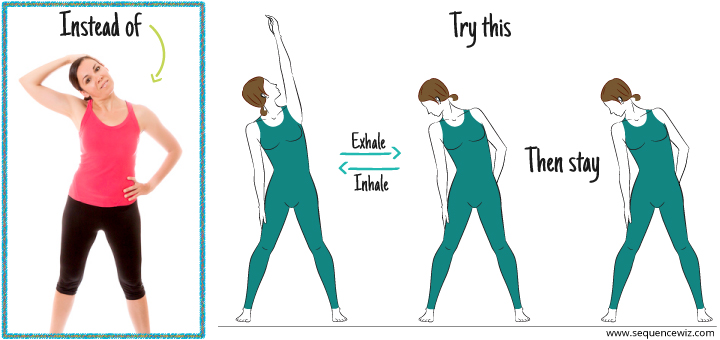
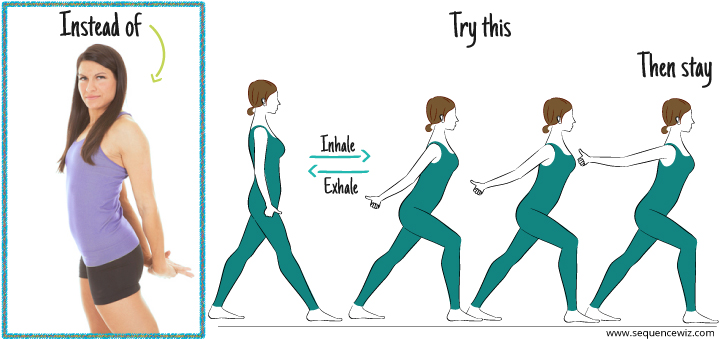
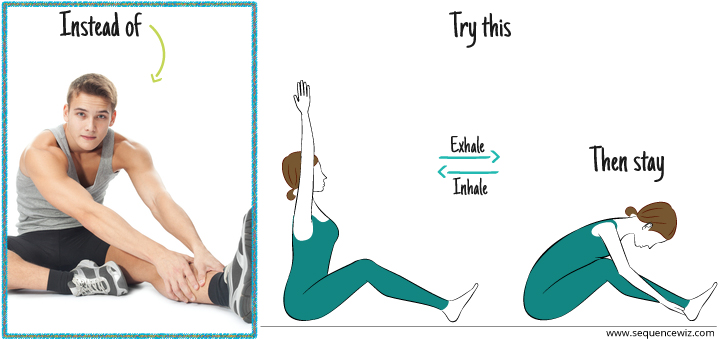
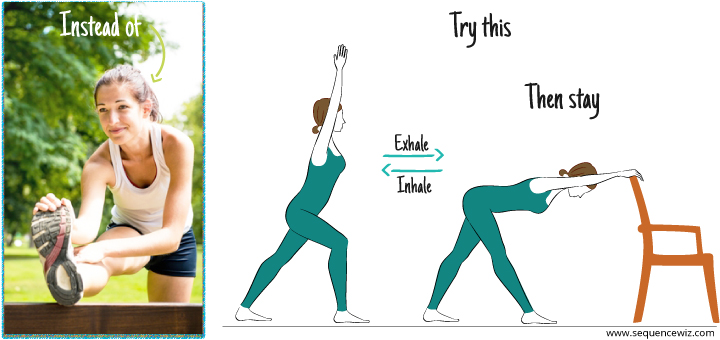
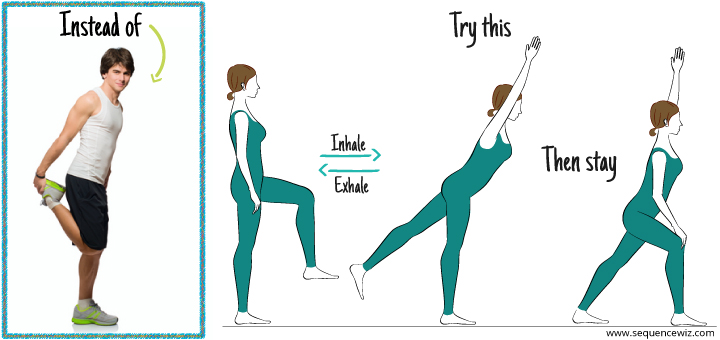
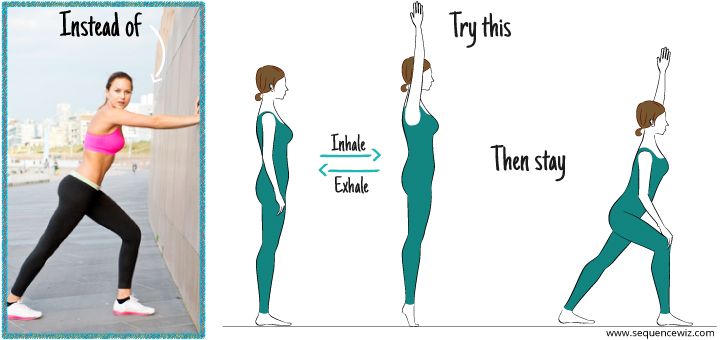



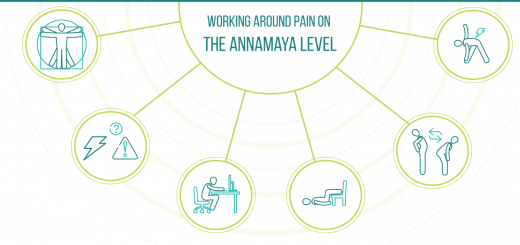
















Excellent! Your writing is clear, concise. Thank you.
Thank you Barbara!
This was very informative and understandable. Thank you tons.
Thank you Cheryl! Glad it was helpful.
Useful stuff
…
These are very helpful. On the neck, is there an equivalent for bending the head forward? From David Coulter’s book on anatomy of hatha yoga, I do the neck stretches he recommends including pulling my head forward to chin on sternum (ch 7, Movements of the Head and Neck), one benefit of which is for the shoulder stand.
Do you recommend something different for this?
Thank you.
Thank you Bill! I have a whole post on stretching the neck that you might find useful. I find those movements to be much more effective then just leaning the head forward. Let me know what you think!
Thank you, Olga. Very helpful.